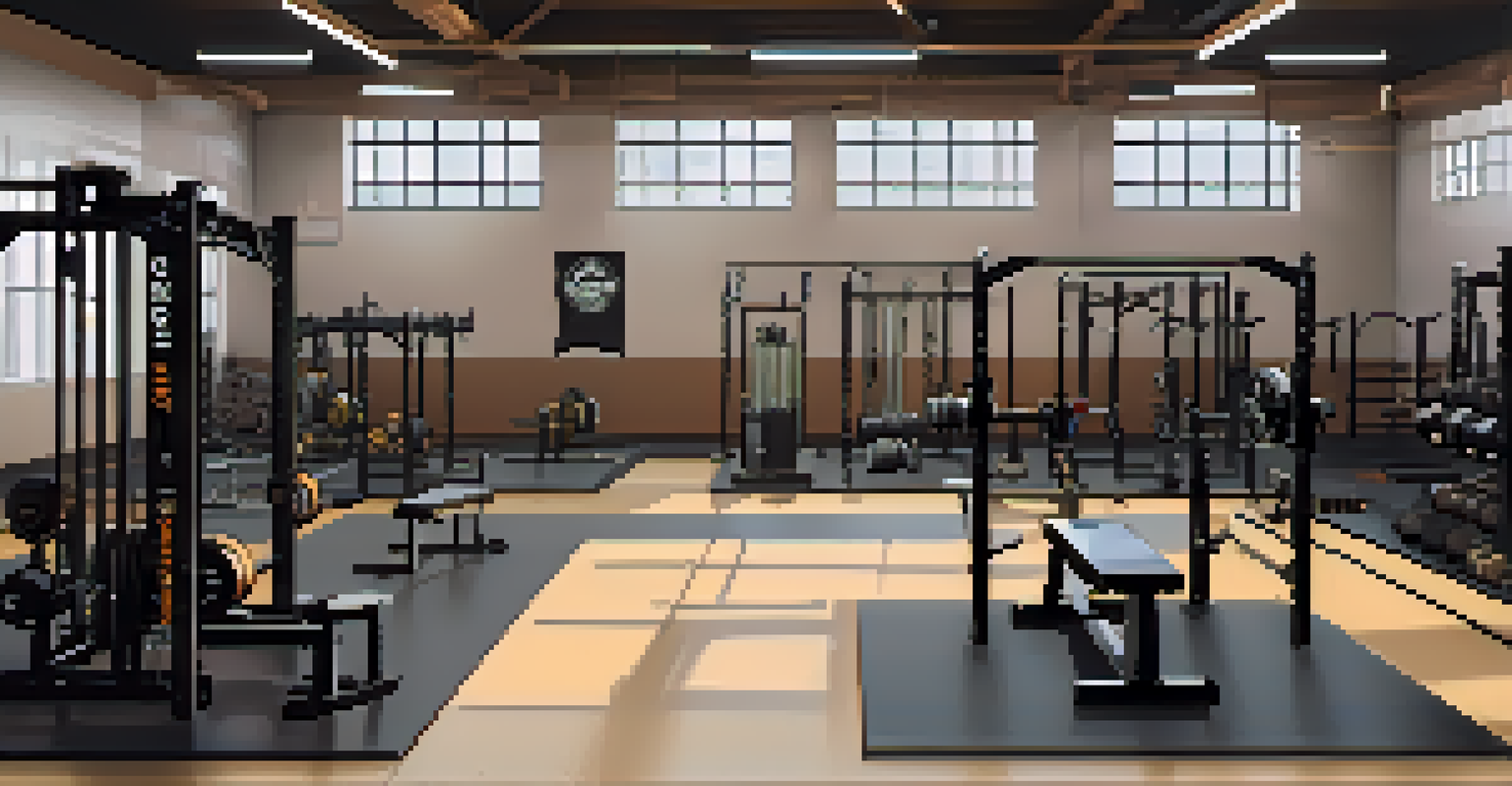Understanding the Squat: Technique Tips for New Powerlifters

Why the Squat is a Key Lift in Powerlifting
The squat is often referred to as the king of powerlifting exercises. It engages multiple muscle groups, making it essential for building overall strength. Whether you're aiming to improve your squat numbers or enhance your athletic performance, mastering this lift is crucial.
Strength does not come from physical capacity. It comes from an indomitable will.
This compound movement primarily targets the quadriceps, hamstrings, and glutes, but also works your core and lower back. The benefits extend beyond just muscle building; squats improve your balance, flexibility, and mobility. Essentially, a solid squat can enhance your performance in other lifts and everyday activities.
For new powerlifters, understanding the squat's importance sets the foundation for future growth. As you progress, this lift will be your best friend in pushing your limits and achieving your goals. Embrace it, and you'll be well on your way to becoming a better lifter.
Proper Squat Form: The Foundation of Success
Having proper squat form is vital to maximize effectiveness and prevent injury. Start by standing with your feet shoulder-width apart, toes slightly pointed out. This position sets you up for a strong, stable base as you descend into the squat.

As you lower your body, think about bending at the hips and knees simultaneously. Keep your chest up and back straight to maintain a neutral spine. Imagine sitting back into a chair, which helps you engage your glutes and redistribute weight properly.
Squats Build Overall Strength
The squat is a foundational exercise that engages multiple muscle groups, essential for enhancing both powerlifting performance and daily activities.
Finally, push through your heels to return to the starting position. Focusing on form will not only enhance your performance but also build muscle memory for future workouts. Remember, quality over quantity is key here—don't rush the process!
Breathing Techniques: Supporting Your Squat
Breathing properly during a squat can make a significant difference in your performance. Take a deep breath in before you begin your descent, filling your belly with air. This technique creates intra-abdominal pressure, providing stability and support for your spine.
Success is the sum of small efforts, repeated day in and day out.
As you lower into the squat, hold your breath until you reach the bottom position. This will help you maintain that necessary tension throughout the movement. Once you’re ready to push back up, exhale forcefully as you drive through your heels to return to standing.
Mastering your breathing not only enhances your squat performance but also helps you develop better overall body control. Think of your breath as the fuel that powers your lift, allowing you to push through challenging sets with confidence.
Foot Placement: Finding Your Ideal Stance
Foot placement can vary from person to person, so it's essential to find what works best for you. A common starting point is to position your feet shoulder-width apart or slightly wider, with your toes pointed outward. This stance allows for better depth and stability during the squat.
Experiment with your foot position to see where you feel the most comfortable and balanced. Some lifters may prefer a narrower stance, while others might find a wider stance gives them better leverage. Just remember that comfort and stability should be your primary focus.
Proper Form Prevents Injury
Maintaining correct squat form is crucial for maximizing effectiveness and minimizing the risk of injury during this key lift.
As you practice, pay attention to how different foot placements affect your lift. Finding your ideal stance will not only improve your squat but also contribute to the overall effectiveness of your training routine. Trust your instincts and adjust as necessary.
Depth Matters: How Low Should You Go?
When it comes to squats, depth is a hot topic among lifters. The general rule of thumb is that you should aim to lower your hips below parallel, where your thighs are at least parallel to the ground. This depth ensures you're engaging the right muscles and maximizing your strength gains.
However, every lifter's anatomy is different, and some may find it challenging to reach that depth due to flexibility or mobility issues. If this is the case, focus on improving your range of motion through targeted stretching and mobility exercises. It's better to squat at a depth that feels comfortable rather than compromising your form.
Ultimately, as you become more proficient, aim to gradually increase your squat depth. The deeper you can go while maintaining proper form, the more effective your training will be. Remember, it's a journey, so be patient with yourself as you work towards achieving that perfect squat depth.
Common Mistakes to Avoid in Your Squat Technique
Even experienced lifters can fall victim to squat mistakes, especially when starting out. One common error is letting the knees cave inward as you lower into the squat. This positioning can put undue stress on the joints and increase your risk of injury, so focus on pushing your knees outward.
Another mistake is leaning too far forward, which can compromise spinal alignment. Keep your chest up and your back straight to maintain a neutral position. Visualize a straight line from your head to your tailbone to ensure proper alignment throughout the lift.
Consistency Fuels Progress
Regularly incorporating squats into your training routine is vital for strength development and achieving long-term powerlifting goals.
Finally, avoid using too much weight too soon. It's tempting to want to lift heavy, but prioritizing form over the amount of weight is crucial for long-term success. Take your time, and build up your strength gradually. Your body will thank you for it!
The Importance of Consistency in Training
Consistency is key in powerlifting, especially with the squat. Developing a regular training schedule allows your body to adapt and grow stronger over time. Aim to include squats in your weekly routine, focusing on various aspects like volume, intensity, and technique.
Tracking your progress is vital for staying motivated and identifying areas for improvement. Consider keeping a training journal where you can log your sets, reps, and any notes about your form or how you felt during the workout. This practice will help you stay accountable and celebrate your achievements.

Remember, Rome wasn't built in a day, and neither are strong squats. Embrace the journey, and trust the process as you work towards your powerlifting goals. With patience and dedication, you'll see the fruits of your labor in no time.